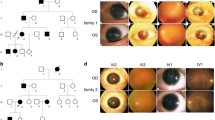Abstract
The developmental birth eye disorder of iris is known as aniridia. Heterozygous PAX6 gene, which causes human aniridia and small eye in mice, is located on chromosome 11p13. The variability had been documented between the affected individuals within the families, is due to genotypic variation. Haploinsufficiency renders PAX6 allele non-functional or amorphic, however it presents hypomorphic or neomorphic alleles. India is not a well-studied ethnic group, hence the focus on congenital aniridia gene analysis supports the literature and the phenotypic association were analysed both in sporadic as well as familial. The consistent association of truncating PAX6 mutations with the phenotype is owing to non-sense-mediated decay (NMD). It is presumed that the genetic impact of increased homozygosity and heterozygocity in Indian counter part arises as the consequence of consanguineous marriages. The real fact involved in congenital aniridia with other related phenotypes with PAX6 mutations are still controversial.
Similar content being viewed by others
References
Shaw MW, Falls HF, Neel JV. Congenital aniridia. Am J Hum Genet 1960; 12:389–415.
Glaser T, Walton DS, Maas RL. Genomic structure, evolutionary conservation and aniridia mutations in the human PAX6 gene. Nat Genet 1992; 2:232–239.
Churchill A, Booth A. Genetics of aniridia and anterior segment dysgenesis. Br J Ophthalmol 1996; 80:669–673.
Glaser T, Jepeal L, Edwards JG et al. PAX6 gene dosage effect in a family with congenital cataracts, aniridia, anophthalmia and central nervous system defects. Nat Genet 1994; 7:463–471.
Ton CC, Hirvonen H, Miwa H et al. Positional cloning and characterization of a paired-box and homeobox-containing gene from the aniridia region. Cell 1991; 67:1059–1074.
Hanson IM, Seawright A, Hardman K et al. PAX6 mutations in aniridia. Hum Mol Genet 1993; 2:915–920.
Wilson DS, Guenther B, Desplan C et al. High resolution crystal structure of a paired (PAX) class cooperative homeodomain dimer on DNA. Cell 1995; 82:709–719.
Xu HE, Rould MA, Xu W et al. Crystal structure of the human PAX6 paired domain-DNA complex reveals specific roles for the linker region and carboxy-terminal subdomain in DNA-binding. Genes Dev 1999; 13:1263–1275.
Simpson TI, Price DJ. PAX6, a pleiotropic player in development. Bioassays 2002; 24:1041–1051.
Tzoulaki I, White IMS, Hanson IM. PAX6 mutations: genotype-phenotype correlations. BMC Genetics 2005; 6:27–39.
Azuma N, Yamaguchi Y, Handa H et al. Mutations of the PAX6 gene detected in patients with a variety of optic-nerve malformations. Am J Hum Genet 2003; 72:1565–1570.
Song SJ, Liu YZ, Cong RC et al. PAX6 mutation caused brain abnormalities in humans. Beijing Da Xue Xue Bao 2005; 37:48–50
Nallathambi J, Neethirajan G, Shashikant S et al. PAX6 missense mutations associated in patients with optic nerve malformation. Mol Vis 2006; 12:236–242.
Neethirajan G, Hanson IM, Krishnadas SR et al. A novel PAX6 gene mutation in an Indian aniridia patient. Mol Vis 2003; 9:205–209.
Nelson LB, Spaeth GL, Nowinski TS et al. Aniridia: a review. Surv Ophthalmol 1984; 26:621–642.
Neethirajan G, Krishnadas SR, Vijayalakshmi P et al. PAX6 gene variations associated with aniridia in south India. BMC Med Genet 2004; 5:9.
Neethirajan G, Collinson JM, Krishnadas SR et al. De novo deletions in the paired domain of PAX6 in south Indian aniridic patients. J Hum Genet 2004; 49:647–649.
Neethirajan G, Nallathambi J, Krishnadas SR et al. Identification of novel mutant PAX6 alleles in Indian cases of familial aniridia. BMC Ophthalmol 2006; 6:28
van Heyningen V, Williamson KA. PAX6 in sensory development. Hum Mol Genet 2002; 11:1161–1167.
Chao LY, Mishra R, Strong LC et al. Missense mutations in the DNA-binding region and termination codon in PAX6. Hum Mutat 2003; 21:138–145.
Negishi K, Azuma N, Yamada M. Various phenotypic expressions of familial aniridia with a PAX6 mutation. Br J Ophthalmol 1999; 83:991–992.
Chao LY, Mishra R, Strong LC et al. Missense mutations in the DNA-binding region and termination codon in PAX6. Hum Mutat 2003; 21:138–145.
Gupta SK, De Becker I, Tremblay F et al. Genotype/phenotype correlations in aniridia. Am J Ophthalmol 1998; 126: 203–210.
Byers PH. Killing the messenger: new insights into nonsense-mediated mRNA decay. J Clin Invest 2002; 109:3–6.
Gronskov K, Olsen JH, Sand A et al. Population-based risk estimates of Wilms tumor in sporadic aniridia: a comprehensive mutation screening procedure of PAX6 identifies 80% of mutations in aniridia. Hum Genet 2001; 109:11–18.
Author information
Authors and Affiliations
Corresponding author
Rights and permissions
About this article
Cite this article
Neethirajan, G., Solomon, A., Krishnadas, S.R. et al. Genotype/phenotype association in Indian congenital aniridia. Indian J Pediatr 76, 513–517 (2009). https://doi.org/10.1007/s12098-009-0075-4
Received:
Accepted:
Published:
Issue Date:
DOI: https://doi.org/10.1007/s12098-009-0075-4




